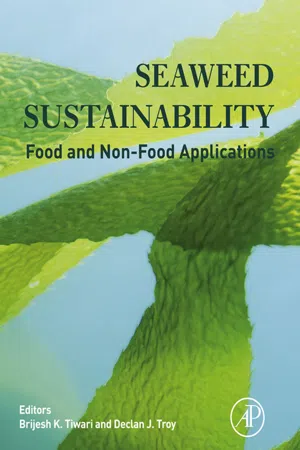
- 472 pages
- English
- ePUB (mobile friendly)
- Available on iOS & Android
About this book
Seaweed Sustainability: Food and Non-Food Applications is the only evidence-based resource that offers an abundance of information on the applications of seaweed as a solution to meet an increasing global demand for sustainable food source.The book uncovers seaweed potential and describes the various sources of seaweed, the role of seaweeds as a sustainable source for human food and animal feeds, and the role of seaweed farming for sustainability. In addition to harvesting and processing information, the book discusses the benefits of seaweed in human nutrition and its nutraceutical properties.- Offers different perspectives by presenting examples of commercial utilization of wild-harvested or cultivated algae, marine and freshwater seaweeds- Discusses seasonal and cultivar variations in seaweeds for a better understanding of their implications in commercial applications- Includes a wide range of micro and macro algae for food and feed production and provides perspectives on seaweed as a potential energy source
Frequently asked questions
- Essential is ideal for learners and professionals who enjoy exploring a wide range of subjects. Access the Essential Library with 800,000+ trusted titles and best-sellers across business, personal growth, and the humanities. Includes unlimited reading time and Standard Read Aloud voice.
- Complete: Perfect for advanced learners and researchers needing full, unrestricted access. Unlock 1.4M+ books across hundreds of subjects, including academic and specialized titles. The Complete Plan also includes advanced features like Premium Read Aloud and Research Assistant.
Please note we cannot support devices running on iOS 13 and Android 7 or earlier. Learn more about using the app.
Information
Seaweed sustainability – food and nonfood applications
Abstract
Keywords
1. Introduction
1.1. History of seaweeds
1.2. Relevance of seaweeds
Table of contents
- Cover
- Title page
- Table of Contents
- Copyright
- List of Contributors
- Chapter 1: Seaweed sustainability – food and nonfood applications
- Chapter 2: World seaweed utilization
- Chapter 3: Farming of seaweeds
- Chapter 4: Processing of seaweeds
- Chapter 5: Chemical composition of seaweeds
- Chapter 6: Seaweed proteins, peptides, and amino acids
- Chapter 7: Seaweed carbohydrates
- Chapter 8: Seaweed minor constituents
- Chapter 9: Extraction of biomolecules from seaweeds
- Chapter 10: Analytical techniques for bioactives from seaweed
- Chapter 11: Seaweed and food security
- Chapter 12: Identification and selection of algae for food, feed, and fuel applications
- Chapter 13: Seaweeds: a sustainable food source
- Chapter 14: Seaweeds: a nutraceutical and health food
- Chapter 15: Seaweeds: a sustainable feed source for livestock and aquaculture
- Chapter 16: Seaweeds: a sustainable fuel source
- Subject Index